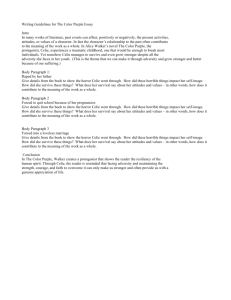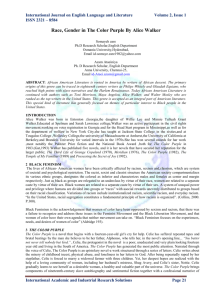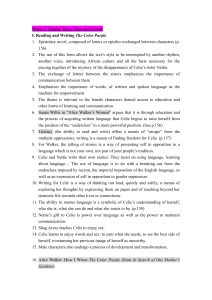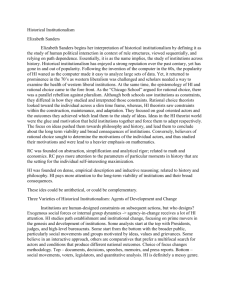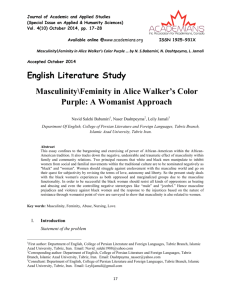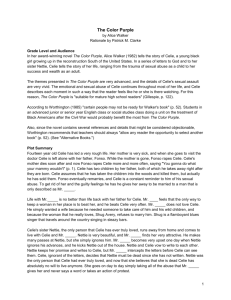The Color Purple Program - Denver Center for the Performing Arts
advertisement
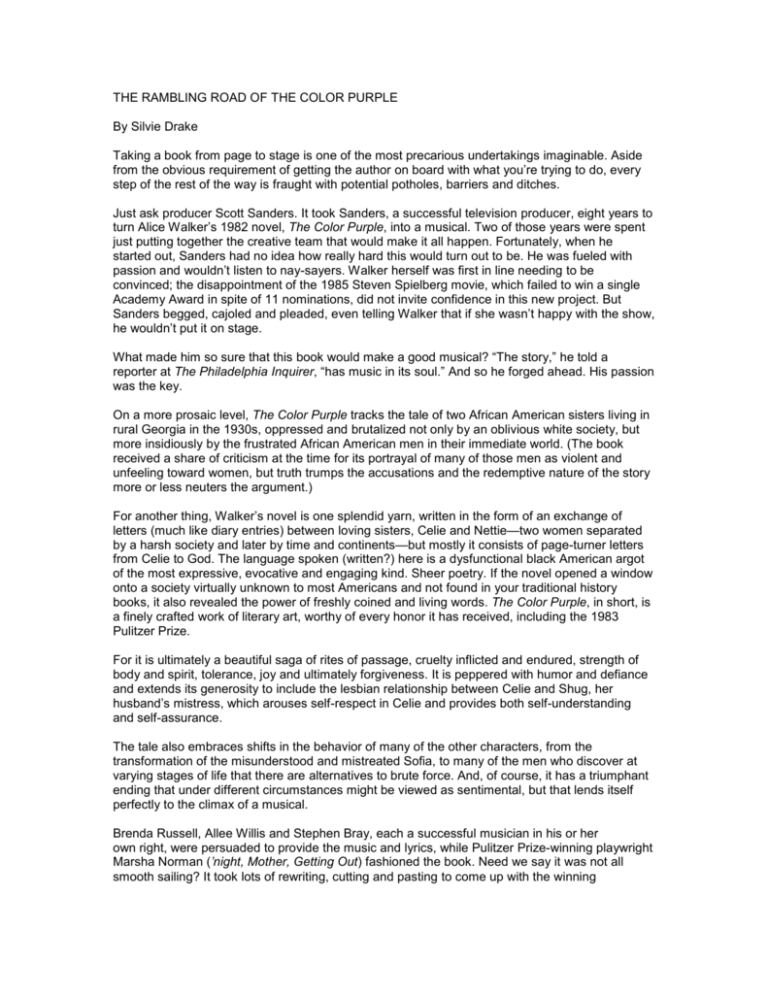
THE RAMBLING ROAD OF THE COLOR PURPLE By Silvie Drake Taking a book from page to stage is one of the most precarious undertakings imaginable. Aside from the obvious requirement of getting the author on board with what you’re trying to do, every step of the rest of the way is fraught with potential potholes, barriers and ditches. Just ask producer Scott Sanders. It took Sanders, a successful television producer, eight years to turn Alice Walker’s 1982 novel, The Color Purple, into a musical. Two of those years were spent just putting together the creative team that would make it all happen. Fortunately, when he started out, Sanders had no idea how really hard this would turn out to be. He was fueled with passion and wouldn’t listen to nay-sayers. Walker herself was first in line needing to be convinced; the disappointment of the 1985 Steven Spielberg movie, which failed to win a single Academy Award in spite of 11 nominations, did not invite confidence in this new project. But Sanders begged, cajoled and pleaded, even telling Walker that if she wasn’t happy with the show, he wouldn’t put it on stage. What made him so sure that this book would make a good musical? “The story,” he told a reporter at The Philadelphia Inquirer, “has music in its soul.” And so he forged ahead. His passion was the key. On a more prosaic level, The Color Purple tracks the tale of two African American sisters living in rural Georgia in the 1930s, oppressed and brutalized not only by an oblivious white society, but more insidiously by the frustrated African American men in their immediate world. (The book received a share of criticism at the time for its portrayal of many of those men as violent and unfeeling toward women, but truth trumps the accusations and the redemptive nature of the story more or less neuters the argument.) For another thing, Walker’s novel is one splendid yarn, written in the form of an exchange of letters (much like diary entries) between loving sisters, Celie and Nettie—two women separated by a harsh society and later by time and continents—but mostly it consists of page-turner letters from Celie to God. The language spoken (written?) here is a dysfunctional black American argot of the most expressive, evocative and engaging kind. Sheer poetry. If the novel opened a window onto a society virtually unknown to most Americans and not found in your traditional history books, it also revealed the power of freshly coined and living words. The Color Purple, in short, is a finely crafted work of literary art, worthy of every honor it has received, including the 1983 Pulitzer Prize. For it is ultimately a beautiful saga of rites of passage, cruelty inflicted and endured, strength of body and spirit, tolerance, joy and ultimately forgiveness. It is peppered with humor and defiance and extends its generosity to include the lesbian relationship between Celie and Shug, her husband’s mistress, which arouses self-respect in Celie and provides both self-understanding and self-assurance. The tale also embraces shifts in the behavior of many of the other characters, from the transformation of the misunderstood and mistreated Sofia, to many of the men who discover at varying stages of life that there are alternatives to brute force. And, of course, it has a triumphant ending that under different circumstances might be viewed as sentimental, but that lends itself perfectly to the climax of a musical. Brenda Russell, Allee Willis and Stephen Bray, each a successful musician in his or her own right, were persuaded to provide the music and lyrics, while Pulitzer Prize-winning playwright Marsha Norman (’night, Mother, Getting Out) fashioned the book. Need we say it was not all smooth sailing? It took lots of rewriting, cutting and pasting to come up with the winning combination. Most of that difficult birthing took place at Atlanta’s Alliance Theatre with director Gary Griffin who was there from the beginning and who steered the show all the way to its successful opening on Broadway on December 1, 2005. Although he deserves all the credit for jump-starting the project, Sanders did not go it entirely alone. Eventually other producers climbed on board: musician Quincy Jones, film producer Harvey Weinstein, financier Roy Furman and, late in the game, the formidable Oprah Winfrey, who had played the role of the feisty Sofia in the film and who agreed, at Sanders’ suggestion, to be The Color Purple’s marquee name as producer. If the musical was not an immediate hit with critics, the public loved it. Some shows are like that. It won only one of the 11 Tony Award nominations it received: Best Leading Actress in a Musical for LaChanze who played Celie. (Trivia time: 11 seems to be a consistently significant number for The Color Purple: the film received 11 Oscar nominations—no wins; the musical received 11 Tony nominations, and the musical recouped its $11 million investment in 11 months—dazzling speed for any musical. By the time it closed on Broadway last February it had grossed a cool $103 million.) So did Sanders know something nobody else knew? Of course not. “No one thought we’d make a nickel off of it, including me,” he acknowledged to The Philadelphia Inquirer. “I was producing television as a day job, assuming that was how I was going to pay my bills.” Some still consider the success of this show a bit of a miracle. Historically musicals with black themes have not done particularly well. The assumption was that there was not enough general interest in their stories. And there were many, many changes to The Color Purple before the show hit Broadway. Griffin likes to think that Walker never edited her story, but simply “invited the ancestors in…” “There’s so many lost songs,” says Jeannette Bayardelle who plays Celie on the tour. “I remember when we were in rehearsal for Broadway how it was just every day. It was like a producer would come in, say Oprah would come in. We would never now what was going on behind the scenes. We would just know we got new music. ‘OK, song so-and-so was cut. This is what we are putting in.’ … I mean… it was tense.” But as a wise writer once said, they don’t remember if it’s late; they only remember if it’s bad. The fact is that all the changes turned out to be improvements, so no one worries about the stress and tensions of the past. Only the successes of the present. Best of all, The Color Purple has attracted a diverse audience into theatres everywhere that the show has played—especially Broadway, that bastion of mostly white tourists, expense-account spenders and suburban visitors. And Walker liked the production well enough that Scott Sanders and Oprah did not have to keep it off the stage.
